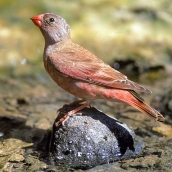Trumpeter Finch (Bucanetes githagineus)
This small passerine measures 11.5-13 cm in length and presents pronounced sexual dimorphism. The male is more striking than the female, which is not unusual among birds, and has a red bill (short and stubby), a pinkish breast, belly and wings, and a greyish head. The female is paler, as are the juveniles. Distribution is relatively widespread (North Africa, southern Iberian Peninsula, Middle East and parts of Asia, including Afghanistan and Pakistan), but in Macaronesia it only breeds in the Canaries, in particular in La Gomera, Tenerife, Gran Canaria, Fuerteventura, Lobos, Lanzarote, La Graciosa and Alegranza. There have also been isolated reports on El Hierro and Montaña Clara and a single sighting in Cape Verde (Sal). This desert-dwelling bird has colonized the Canaries from east to west, supposedly originating from Northwest Africa. Currently, Canary Island populations are considered isolated and belonging to the subspecies B. g. amantum, exclusive to the islands and well-differentiated genetically. It lives in arid and semi-arid environments, such as stony plains with xerophytic vegetation, Euphorbia communities, sand dunes (especially stone walls and rocky areas), malpaíses or badlands and even mountainous terrain, ravine walls and volcanic ridges. It also frequents lowland crops and ravine beds with flowing water, where it goes to drink. On La Graciosa, it nests in the main centre of population. It feeds mainly on grain, composed of seeds and shoots of several succulent and annual plants, but has a special liking for the Patellifolia patellaris. It nests in hollows and rocky crevices, stone walls, under rocks, in derelict buildings and in other very strange locations, such as car tyres and discarded pipes. The breeding season stretches from January to May, and egg-laying takes place at least twice a year, with clutches of 3-6 eggs, though 4-5 are more usual. Courtship and mating behaviour is noticeable because the male flaps its wings erratically and struts about in front of the female, uttering nasal sounds. Outside of the breeding season, it gathers in flocks of dozens of specimens (sometimes over a hundred), which cover large areas in search of food. These flocks are currently seen on the two easternmost islands (Fuerteventura and Lanzarote), Gran Canaria, and to a lesser extent, La Gomera. The main threats are destruction and alteration of habitat, specimens caught to be kept in captivity, nest predation by cats and rats, and possible insecticides used on crops. Numbers have dwindled considerably over the past few decades in Gran Canaria and Tenerife, where it is considered practically extinct. However, populations in Fuerteventura and Lanzarote are in fine fettle.













